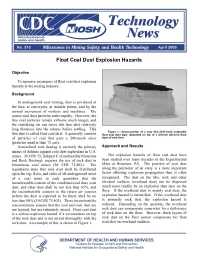Mining Publication: Technology News 515 - Float Coal Dust Explosion Hazards
Original creation date: April 2006
In underground coal mining, dust is produced at the face, at conveyors, at transfer points, and by the normal movement of workers and machines. The coarse coal dust particles settle rapidly. However, the fine coal particles remain airborne much longer, and the ventilating air can move this fine dust relatively long distances into the returns before settling. This fine dust is called float coal dust. It generally consists of particles of coal that pass a 200-mesh sieve (particles smaller than 75 micrometers). Generalized rock dusting is currently the primary means of defense against coal dust explosions in U.S. mines. 30 CFR 75, Subpart E (Combustible Materials and Rock Dusting), requires the use of rock dust in bituminous coal mines (30 CFR 75.402). The regulations state that rock dust shall be distributed upon the top, floor, and sides of all underground areas of a coal mine in such quantities that the incombustible content of the combined coal dust, rock dust, and other dust shall be not less than 65%, and the incombustible content in the return air courses (where the dust is expected to be finer) shall be no less than 80% (30 CFR 75.403). These incombustible concentrations assume that the coal and rock dust are not layered, but are intimately mixed. Float coal dust is a serious explosion hazard if it accumulates on top of the rock dust and is not mixed thoroughly with the rock dust.
Authors: MJ Sapko, ES Weiss, KL Cashdollar
Technology News - April 2006
NIOSHTIC2 Number: 20029929
Pittsburgh, PA: U.S. Department of Health and Human Services, Public Health Service, Centers for Disease Control and Prevention, National Institute for Occupational Safety and Health, DHHS (NIOSH) Publication No. 2006-125, Technology News 515, 2006 Apr; :1-2
See Also
- Coal Dust Explosibility
- Field Evaluation of the Coal Dust Explosibility Meter
- Full-Scale Testing of the Float Dust Deposition Meter
- Funding Opportunities
- How Does Limestone Rock Dust Prevent Coal Dust Explosions in Coal Mines?
- How to use the Coal Dust Explosibility Meter
- Mitigating Coal Dust Explosions in Modern Underground Coal Mines
- Particle Size and Surface Area Effects on Explosibility Using a 20-L Chamber
- Recommendations for a New Rock Dusting Standard to Prevent Coal Dust Explosions in Intake Airways
- Rock Dusting
- Rock Dusting Considerations in Underground Coal Mines
- Technology for Real-Time Monitoring of Coal Dust Explosion Hazards
- Content source: National Institute for Occupational Safety and Health, Mining Program


 ShareCompartir
ShareCompartir
